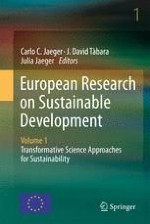2011 | OriginalPaper | Chapter
Dealing with Doom: Tackling the Triple Challenge of Energy Scarcity, Climate Change and Global Inequity
Author : Jos Bruggink
Published in: European Research on Sustainable Development
Publisher: Springer Berlin Heidelberg
Activate our intelligent search to find suitable subject content or patents.
Select sections of text to find matching patents with Artificial Intelligence. powered by
Select sections of text to find additional relevant content using AI-assisted search. powered by
